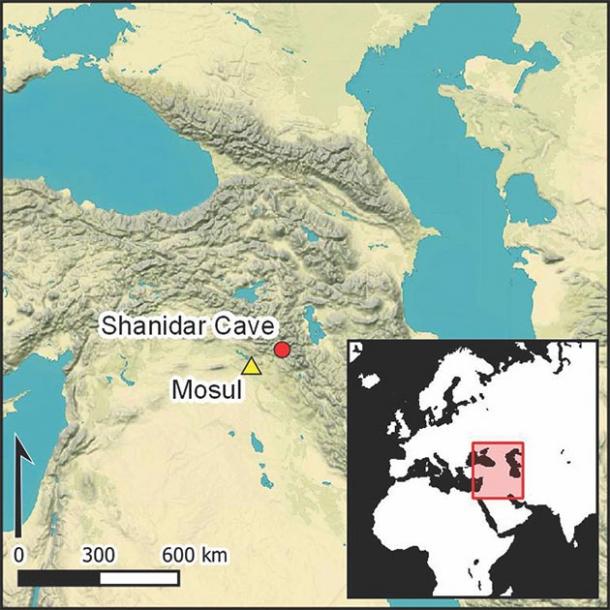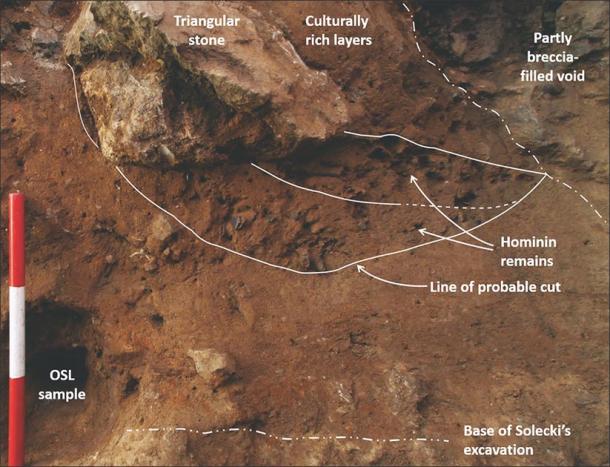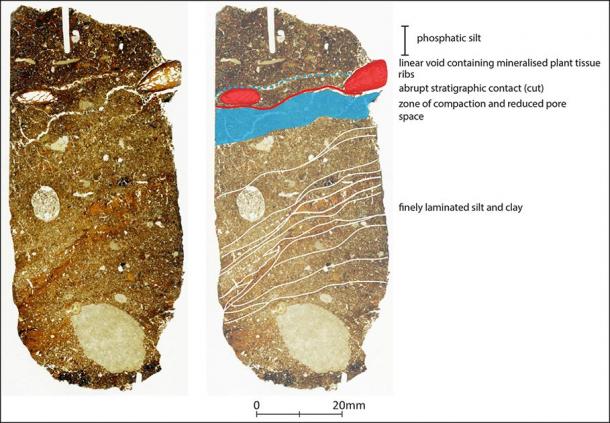There is a longstanding debate about whether Neanderthals buried their dead or if this is a funerary rite unique to our species. However a new study may finally sway skeptics over to the side that intentional Neanderthal burials really did happen.
A multi-disciplinary team of researchers led by members of the CNRS and the Muséum national d’histoire naturelle of France and the University of the Basque Country in Spain have used several methods to prove that a two-year-old Neanderthal child was buried around 41,000 years ago. The child’s remains were found in a rock shelter called La Ferrassie in southwestern France sometime between 1970-1973 and have been stored and forgotten in the collections of the Musée d’archéologie nationale until now.
Science Daily reports that when the team of researchers decided to study the remains they found 47 bones that had been unaccounted for but clearly belong to the Neanderthal child. They read the notebooks and field diaries used by the original excavation team and then analyzed the state of preservation of the bones, as well as the proteins, genetics, and date associated with the remains. Next, the researchers returned to La Ferrassie to see if there were any more bones that were missed by the archaeologists in the past.

Examining material from the 1970s excavations at the Musée d’archéologie nationale, France. Thousands of bone remains were sorted and 47 new fossil remains belonging to the Neandertal child ‘La Ferrassie 8’ were identified. ( Antoine Balzeau – CNRS/MNHN )
They didn’t find any more Neanderthal burials or remains, but the work at the site did allow them to “reconstruct and interpret the spatial distribution of the human remains and the rare associated animal bones,” according to Science Daily . Their study, which is published in Scientific Reports , shows that the Neanderthal child was “buried in a sedimentary layer which inclined to the west (the head, to the east, was higher than the pelvis), while the other stratigraphic layers of the site inclined to the north-east. The bones, which were relatively unscattered, had remained in their anatomical position. Their preservation, better than that of the bison and other herbivores found in the same stratum, indicates a rapid burial after death.”
The combined anthropological, spatial, geochronological, taphonomic, and biomolecular data analysed here suggest that a burial is the most parsimonious explanation,” the authors write in their paper. A CNRS press release declares that “This new information proves that the body of this two-year-old Neandertal child was purposefully deposited in a pit dug in a sedimentary layer around 41,000 years ago.” However the researchers did note that more discoveries are needed to properly “understand the chronology and geographical extension of Neandertal burial practices.”
A ‘Flower Burial’ Indicates Neanderthals Had Death Rites
This isn’t the first time researchers have found evidence for intentional Neanderthal burials. The famous Paleolithic site of Shanidar Cave in Iraq has also provided clues that Neanderthals not only purposely buried their dead, but also performed death rituals.
Between 1951 and the 1960s, Ralph Solceki and his team investigated the Shanidar Cave , in the Baraadost Mountains, which is in the Kurdistan region of Northern Iraq. At a depth of several meters, they found a number of Neanderthal remains that date to the Upper Paleolithic period. This find became world-famous because it seemed to provide evidence of Neanderthal burial practices for the first time.

Shanidar Cave became an iconic Palaeolithic site following Ralph Solecki’s discovery of Neanderthal remains. ( Antiquity Publications Ltd )
According to a study published in Antiquity in February 2020, Solceki had uncovered the “famous flower burial, so-called because of clumps of pollen grains from adjacent sediments.” This appeared to be an intentional burial with flowers, possibly indicating mortuary practices among the Neanderthals and offering evidence that they were capable of symbolic thought and cultural practices .
Articulated Neanderthal Remains
For a long time there were no major digs carried out at Shanidar, despite its status as “an iconic Palaeolithic site,” according to Antiquity. But in 2014 the local Kurdistan regional government backed a new dig at the site, which did not begin until 2015. It was conducted by a team from several leading British universities.
The objective of the research project was to “place Solceki’s findings into a robust paleoclimatic, paleoecological and cultural framework using the full range of modern archaeological science techniques,” reports Antiquity. They did not expect to find any more Neanderthal remains.
Instead, they found the first articulated remains of a Neanderthal in over a generation in a deposit of silt. They uncovered part of a badly damaged cranium and some bones from the torso of a member of the extinct human species.

Excavated Neanderthal skull. (G. Barker / Antiquity Publications Ltd )
The discovery has been named Shanidar Z and is believed to be 70,000 years old and to be the remains of a male, possibly in his 40s. The remains have been analyzed using a variety of techniques that were not available when the cave was first investigated.
Signs of Neanderthal Burial Rituals?
The find was yet another suggestion that at least some Neanderthals were buried. Dr. Emma Pomeroy, lead author of the study, exclusively told Ancient Origins that “We have been able to provide evidence that a scoop was dug in which to place the new individual, and that there are ancient plant remains in the sediments around the bones.” It appears that an existing channel on the cave floor was deepened, something that would have required a great deal of effort.

Location of the Neanderthal remains. (G. Barker / Antiquity Publications Ltd )
This strongly indicates that the individual was intentionally buried. A stone that was possibly a marker was also found near the suspected burial. Dr. Pomeroy told Ancient Origins that “We also have the possibility that stones were used to mark where the bodies were, and for Neanderthals returning multiple times to deposit their dead in the exact same spot.”
Possible Neanderthal Cultural Practices
There is so much evidence that shows that the Neanderthals were far from primitive ape-men. Finds like the indications of Neanderthal burials indicate that they had high cognitive abilities. The discoveries may also suggest that the Neanderthals had some spiritual or even religious beliefs.
According to Dr. Pomeroy, the Neanderthal burials “could hint at some kind of spiritual ideas, or at least compassion for others in the group, care for the dead, and feelings of mourning or loss.” It is impossible to determine if Neanderthals had any beliefs about death, but it is clear that they cared for their dead.

Reconstruction of the possible burial position of the Neanderthal remains; the stone behind the head is shown in grey. (E. Pomeroy / Antiquity Publications Ltd )
An examination of the Shanidar Cave site, especially a micromorphology of sediment retrieved from the cave, shows researchers how the Neanderthals used the site. This could help to understand if Neanderthals’ behavior changed over time, in a similar way to modern humans – and this would indicate higher-order, or even symbolic thinking . This “will be important for understanding more fully the nature and variability of potential cultural behaviors in Neanderthals,” Dr. Pomeroy told Ancient Origins.
How Did Neanderthals Become Extinct?
The micromorphology of sediment could also tell scientists much more about the site and the environment in which the Neanderthals lived . These types of studies could reveal what plants were used in the Neanderthal burial and if they were local. If pollen is found it could also reveal what plants were part of the Neanderthal diet .

Micromorphology thin section through the cut feature containing the Neanderthal remains. (L. Farr / Antiquity Publications Ltd )
Dr. Pomeroy told Ancient Origins that “if we are able to isolate ancient environmental DNA (eDNA) from the sediments, this might give us a greater understanding of Neanderthal genetic variation and variability.” This could reveal a great deal about the extinct species . It may also help researchers to understand why they disappeared about 40,000 years ago.
There are real hopes that some DNA may be extracted from a bone in the skull that was identified during a CT scan. This could help us to understand if Neanderthals in southwest Asia interbred with anatomically modern humans as they came out of Africa . There is evidence, elsewhere in Eurasia, that modern humans and Neanderthals mated.
The results of the Shanidar Cave study discussing Neanderthal burials are published in Antiquity.
Top Image: Artist’s reconstruction of a Neanderthal burials. Source: Emmanuel Roudier
By Ed Whelan
Updated on December 11, 2020.
Related posts:
Views: 0
 RSS Feed
RSS Feed
















 December 12th, 2020
December 12th, 2020  Awake Goy
Awake Goy  Posted in
Posted in  Tags:
Tags: 
















